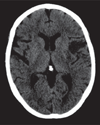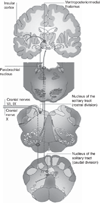Altered taste and stroke: a case report and literature review
- PMID: 23340074
- PMCID: PMC3777265
- DOI: 10.1310/tsr2001-78
Altered taste and stroke: a case report and literature review
Abstract
Patients with altered taste perception following stroke are at risk for malnutrition and associated complications that may impede recovery and adversely affect quality of life. Such deficits often induce and exacerbate depressive symptomatology, which can further hamper recovery. It is important for clinicians and rehabilitation specialists to monitor stroke patients for altered taste perception so that this issue can be addressed. The authors present the case of a patient who experienced an isolated ischemic infarct affecting a primary cortical taste area. This case is unusual in that the isolated injury allowed the patient to remain relatively intact cognitively and functionally, and thus able to accurately describe her taste-related deficits. The case is further used to describe the relevant neurological taste pathways and review potential taste-related therapies.
Figures


Similar articles
-
Weight reduction due to stroke-induced dysgeusia.Eur Neurol. 2004;51(1):47-9. doi: 10.1159/000075089. Epub 2003 Nov 21. Eur Neurol. 2004. PMID: 14639032 No abstract available.
-
Loss of taste-induced hypertension--caveat for taste modulation as a therapeutic option in obesity.Eat Weight Disord. 2007 Mar;12(1):e11-3. doi: 10.1007/BF03327775. Eat Weight Disord. 2007. PMID: 17384519
-
Taste perception abnormalities after acute stroke in postmenopausal women.J Clin Neurosci. 2009 Jun;16(6):797-801. doi: 10.1016/j.jocn.2008.08.038. Epub 2009 Mar 18. J Clin Neurosci. 2009. PMID: 19297163
-
Aroma and taste perceptions with Alzheimer disease and stroke.Crit Rev Food Sci Nutr. 2013;53(7):760-9. doi: 10.1080/10408398.2011.559557. Crit Rev Food Sci Nutr. 2013. PMID: 23638935 Review.
-
Taste and odor abnormalities in cancer patients.J Support Oncol. 2009 Mar-Apr;7(2):58-65. J Support Oncol. 2009. PMID: 19408458 Review.
Cited by
-
Poor nutrition and alcohol consumption are related to high serum homocysteine level at post-stroke.Nutr Res Pract. 2015 Oct;9(5):503-10. doi: 10.4162/nrp.2015.9.5.503. Epub 2015 Aug 20. Nutr Res Pract. 2015. PMID: 26425280 Free PMC article.
-
Neuronutrition and Its Impact on Post-Stroke Neurorehabilitation: Modulating Plasticity Through Diet.Nutrients. 2024 Oct 30;16(21):3705. doi: 10.3390/nu16213705. Nutrients. 2024. PMID: 39519537 Free PMC article. Review.
-
Assessing Taste and Smell Dysfunction in Acute and Chronic Stroke Patients: Insights From an Adapted Bedside Questionnaire.Eur J Neurol. 2025 May;32(5):e70089. doi: 10.1111/ene.70089. Eur J Neurol. 2025. PMID: 40342227 Free PMC article.
-
Counterregulation of insulin by leptin as key component of autonomic regulation of body weight.World J Diabetes. 2014 Oct 15;5(5):606-29. doi: 10.4239/wjd.v5.i5.606. World J Diabetes. 2014. PMID: 25317239 Free PMC article. Review.
-
The Phantom Satiation Hypothesis of Bariatric Surgery.Front Neurosci. 2021 Feb 1;15:626085. doi: 10.3389/fnins.2021.626085. eCollection 2021. Front Neurosci. 2021. PMID: 33597843 Free PMC article.
References
-
- Ropper AH, Samuels MA. Adams and Victor’s Principles of Neurology. 9th ed. New York: McGraw-Hill Medical; 2009.
-
- Goto N, Yamamoto T, Kaneko M, Tomita H. Primary pontine hemorrhage and gustatory disturbance: clinicoanatomic study. Stroke. 1983;14(4):507–511. - PubMed
-
- Nakajima Y, Utsumi H, Takahashi H. Ipsilateral disturbance of taste due to pontine haemorrhage. J Neurol. 1983;229(2):133–136. - PubMed
-
- Sunada I, Akano Y, Yamamoto S, Tashiro T. Pontine haemorrhage causing disturbance of taste. Neuroradiology. 1995;37(8):659. - PubMed
Publication types
MeSH terms
Grants and funding
LinkOut - more resources
Full Text Sources
Other Literature Sources
Medical
